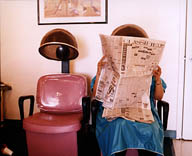![]()
![]() ortunately,
even during a Bad Hair Week, I don't have to worry about unruly curls.
That wasn't always the case. When I was in elementary school, my mother
gave me a home permanent. Memories of the resulting Little Orphan Annie
frizz have kept me away from permanents permanently. I have straight hair
and that's fine with me.
ortunately,
even during a Bad Hair Week, I don't have to worry about unruly curls.
That wasn't always the case. When I was in elementary school, my mother
gave me a home permanent. Memories of the resulting Little Orphan Annie
frizz have kept me away from permanents permanently. I have straight hair
and that's fine with me.
 When
you curl your hair—whether it's with water and styling gel or a
permanent-wave kit—you are messing with the chemical bonds that
keep the protein fibers of your hair's cortex stuck together. These chemical
bonds include hydrogen bonds—a weak attachment that comes about
when a hydrogen atom dangling off one protein is attracted to the oxygen
atom dangling off another protein.
When
you curl your hair—whether it's with water and styling gel or a
permanent-wave kit—you are messing with the chemical bonds that
keep the protein fibers of your hair's cortex stuck together. These chemical
bonds include hydrogen bonds—a weak attachment that comes about
when a hydrogen atom dangling off one protein is attracted to the oxygen
atom dangling off another protein.
Water is made of hydrogen and oxygen—it's called H 2 O because every molecule of water has two hydrogen atoms (H 2 ) and an oxygen atom (O). When you wet your hair, water molecules sneak in between the proteins of the cortex and join these hydrogen bonds. Your hair swells up, absorbing up to 30 percent of its weight in water.
In wet hair, one protein molecule doesn't bond directly to another protein molecule. Instead, a protein is stuck to a water molecule, which is sticking to another water molecule, which is sticking to another protein. That's much weaker than having one protein stuck directly to the other protein—which is why wet hair is much weaker and more likely to break than dry hair.
That's also why you can curl your hair when it's wet. If you set your wet hair in curlers or pull your curly hair straight, then let it dry in this new shape, the hydrogen bonds will reform in a new position. Of course, when your hair gets wet again, those hydrogen bonds will weaken and then reform in their original position, giving you back the hair you didn't want—making curly hair straight, straight hair curly.
 If
you want a permanent change, you can perm your hair. In a perm, you don't
just break hydrogen bonds, you also break the disulfide bonds that hold
the proteins together. You add chemicals that break the disulfide bonds
(bonds between sulfur atoms). Then you reshape your hair and add chemicals
that reconstruct those disulfide bonds, holding your hair in a new shape.
Since these disulfide bonds withstand water, your new hairdo will be waterproof.
If
you want a permanent change, you can perm your hair. In a perm, you don't
just break hydrogen bonds, you also break the disulfide bonds that hold
the proteins together. You add chemicals that break the disulfide bonds
(bonds between sulfur atoms). Then you reshape your hair and add chemicals
that reconstruct those disulfide bonds, holding your hair in a new shape.
Since these disulfide bonds withstand water, your new hairdo will be waterproof.
Unfortunately, about 10 percent of the disulfide bonds that break when you are perming your hair don't reform again. So the proteins in permed hair are held together more weakly, and the hair is more likely to break and get split ends. That's the price you pay for messing with Mother Nature.

I've steered clear of perms,
but as my hairdresser (and all of you out there reading this) knows, I've
done a few other experiments with hair and chemicals. After extensive
experimentation, I've decided that it's true. Blondes do have more fun.
Before I talk about the joys of changing your hair color, let me tell you how your hair gets its natural hair color. In your hair follicles, there are cells called melanocytes that make pigments called melanins. A hair's natural color is determined by how much and what kind of melanins are in the hair's cortex. Different melanins combine to produce the natural colors of human hair. In general, the darker the hair, the more melanin it has. If a hair doesn't have any melanin, it looks white. "Gray" hair is a mixture of pigmented and unpigmented hair. As you age, the melanocytes in your hair follicles slow down or stop working altogether and your hair goes gray or white.

